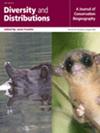Abundant species distribution models (SDMs) of deep-sea corals and sponges (DSCS) allow one to make community-level predictions about DSCS. Pairing that with the conservation information of Vulnerable Marine Ecosystems (VMEs) due to their sensitivity to seafloor trawling, one can assess the efficacy of established seafloor protections, known as Essential Fish Habitat and Conservation Areas (trawl closure areas), in the United States West Coast on a multi-taxon basis. From this, we seek to answer the following questions: (1) can accurate multi-taxon, trawl-sensitive DSCS distribution predictions be made for the US West Coast and (2) to what extent do current trawl protections overlap with multi-taxon distribution predictions and what are the conservation and management implications?
United States West Coast marine waters.
A cluster analysis was run on 40 SDMs of DSCS, identifiable as VME indicators and assigned a VME indicator score based on criteria used by regional fisheries management organisations. SDMs of taxa in clusters were stacked and averaged to produce stacked SDM (S-SDM) prediction maps. All prediction maps were classified into five habitat suitability classes to facilitate interpretation. The total area within benthic ecoregion-bathymetric boundaries and the percentage overlap with the bottom trawl closure zone were computed for spatial contextualization and to determine protection coverage for S-SDMs, respectively.
Cluster analysis identified 10 groups that represent unique S-SDMs for the region. Taxa clustered together have previously been documented together in surveys but some novel associations are reported. Geographically, the predicted occurrences can range along the entire western continental margin, be highly restricted, or constrained by recognised biogeographic boundaries. VME indicator metrics ranged from low to moderate. When trawl coverage was computed relative to the suitability's prevalence in the modelling domain, trawl protection was shown to be large for the highest suitability classes for most of the S-SDMs.
Results indicate the clustering approach has some strengths in identifying known and documented associations between DSCS taxa but some are problematic and produce low to moderate VME indicator scores for S-SDMs, undercutting the conservation information the metric should convey. Coupled with the small predicted areas of the highest suitability classes, the wholesale recommendation for this approach for management purposes is difficult. We discuss avenues for methodological improvements.



